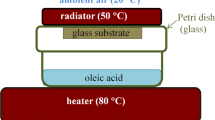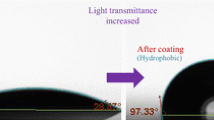Abstract
Glass surface properties were investigated after air, nitrogen, oxygen and argon plasmas treatment. The samples were treated by low pressure plasma for 30 s with the gas flow 22 sccm. After modification kinetics of water spreading was measured. Surface topography was determined using optical profilometry, scanning electron microscopy and X-ray photoelectron spectroscopy. It was found that using all types of gases plasma treatment leads to decrease of the surface roughness. The kinetics of water spreading depends on gases type used for glass plates modification. Analyzing the photoelectron spectra the increase of oxygen amount on the surface was observed. For the increase of wettability and adhesive properties of plasma treated glass, the introduction of new polar functional groups on the surface has greater influence than changing the surface roughness.
Similar content being viewed by others
References
Chibowski, E., Hołysz, L., and Terpilowski, K., Investigation of super-hydrophobic effect of PMMA layers with different fillers deposited on glass support, Colloid Surf., A, 2006, vol. 291, pp. 181–190.
Holysz, L., Terpilowski, K., Zarko, V., and Chibowski, E., Superhydrophobic polystyrene layers filled with silica on glass, Surf. Innovations, 2013, vol. 1, no. 1 (Suppl.), pp. 52–59.
Terpilowski, K., Rymuszka, D., Goncharuk, O.V., Sulym, I.Ya., and Gun’ko, V.M., Wettability of modified silica layers deposited on glass support activated by plasma, Appl. Surf. Sci., 2015, vol. 353, pp. 843–850.
Terpilowski, K., Surface free energy of superhydrophobic materials obtained by deposition of polymeric particles on glass, Adv. Contact Angle, Wettability Adhes., 2015, vol. 2, pp. 381–395.
Chibowski, E., Holysz, L., and Terpilowski, K., Effect of magnetic field on deposition and adhesion of calcium carbonate particles on different substrates, J. Adhes. Sci. Technol., 2003, vol. 17, no. 15, pp. 2005–2021.
Szczes, A., Chibowski, E., and Holysz, L., Influence of ionic surfactants on the properties of freshly precipitated calcium carbonate, Colloid Surf., A, 2007, vol. 297, pp. 14–18.
Chibowski, E., Holysz, L., and Szczes, A., Adhesion of in situ precipitated calcium carbonate in the presence and absence of magnetic field in quiescent conditions on different solid surfaces, Water Res., 2003, vol. 37, pp. 4685–4692.
Chibowski, E., Delgado, A.V., Rudzka, K., Szczes, A., and Holysz, L., Surface modification of glass plates and silica particles by phospholipid adsorption, J. Colloid Interface Sci., 2011, vol. 353, pp. 281–289.
Chibowski, E., Jurak, M., Holysz, L., and Szczes, A., Wetting properties of model biological membranes, Curr. Opin. Colloid Interface Sci., 2014, vol. 19, pp. 368–380.
Golabek, M. and Holysz, L., Changes in wetting and energetic properties of glass caused by deposition of different lipid layers, Appl. Surf. Sci., 2010, vol. 256, pp. 5463–5469.
Szymczyk, K. and Janczuk, B., Wettability of a glass surface in the presence of two nonionic surfactant mixtures, Langmuir, 2008, vol. 24, pp. 7755–7760.
Jung, H., Gweon, B., Kim, D.B., and Choe, W., A simple approach to surface modification using polytetrafluoroethylene (PTFE) with laminar and turbulent flows of micro plasma jets at atmospheric pressure, Plasma Process. Polym., 2011, vol. 8, pp. 535–541.
Bessmertnyi, V.S., Plasma treatment of glasses (A review), Glass Ceram., 2001, vol. 58, pp. 121–124.
Min’ko, N.I., Bessmertnyi, V.S., and Dyumin, P.S., Use of alternative energy sources in the technology of glass and glass ceramic materials (A review), Glass Ceram., 2002, vol. 59, pp. 77–79.
Chan, C.M., Ko, T.M., and Hiraoka, H., Polymer surface modification by plasmas and photons, Surf. Sci. Rep., 1996, vol. 24, pp. 3–4.
Chu, P.K., Chen, J.Y., Wang, L.P., and Huang, N., Plasma-surface modification of biomaterials, Mater. Sci. Eng., R, 2002, vol. 36, pp. 143–206.
Yamamoto, T., Okubo, M., Imai, N., and Mori, Y., Improvement on hydrophilic and hydrophobic properties of glass surface treated by nonthermal plasma induced by silent corona discharge, Plasma Chem. Plasma Process., 2004, vol. 24, no. 1, pp. 1–12.
Lim, K.-B. and Lee, D.-Ch., Surface modification of glass and glass fibres by plasma surface treatment, Surf. Interface Anal., 2004, vol. 36, pp. 254–258.
Homola, T., Matousek, J., Kormunda, M., Wu, L.Y.L., and Cernak, M., Plasma treatment of glass surfaces using diffuse coplanar surface barrier discharge in ambient air, Plasma Chem. Plasma Process., 2013, vol. 33, pp. 881–894.
Chappel, P.J.C., Brown, J.R., George, G.A., and Willis, H.A., Surface modification of extended chain polyethylene fibres to improve adhesion to epoxy and unsaturated polyester resins, Surf. Interface Anal., 1991, vol. 17, p. 143.
Gupta, B., Hilborn, J., Hollenstein, Ch., Plummer, C.J.G., Houriet, R., and Xanthopoulos, N., Surface modification of polyester films by RF plasma, J. Appl. Polym. Sci., 2000, vol. 78, p. 1083.
Bucek, A., Homola, T., Aranyosiová, M., Velic, D., Plecenik, T., Havel, J., Stahel, P., and Zahoranová, A., Atmospheric pressure nonequilibrium plasma treatment of glass surface, Chem. Listy, 2008, vol. 102, pp. 1459–1462.
Krishnamurthy, V. and Kamel, I.L., Argon plasma treatment of glass surfaces, J. Mater. Sci., 1989, vol. 24, pp. 3345–3352.
Chibowski, E. and Terpilowski, K., Comparison of apparent surface free energy of some solids determined by different approaches, Contact Angle, Wettability Adhes., 2009, vol. 6, pp. 283–299.
Fowkes, M., Attractive forces at interfaces, Ind. Eng. Chem., 1964, vol. 56, no. 12, p. 40.
So, L., Ng, N., Bilek, M., Pigram, P.J., and Brack, N., X-ray photoelectron spectroscopic study of the surface chemistry of soda-lime glass in vacuum, Surf. Interface Anal., 2006, vol. 38, pp. 648–651.
Author information
Authors and Affiliations
Corresponding author
Additional information
The article is published in the original.
Rights and permissions
About this article
Cite this article
Terpilowski, K., Rymuszka, D. Surface properties of glass plates activated by air, oxygen, nitrogen and argon plasma. Glass Phys Chem 42, 535–541 (2016). https://doi.org/10.1134/S1087659616060195
Received:
Published:
Issue Date:
DOI: https://doi.org/10.1134/S1087659616060195




